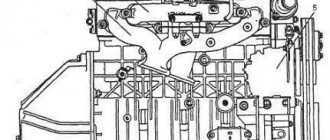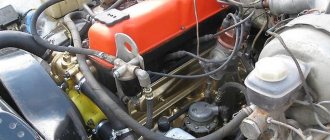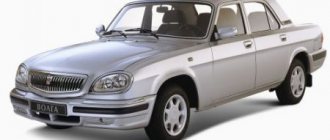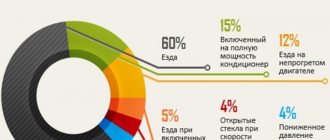The history of the famous Volga car begins in 1956. For a long time, this car was a symbol of the Soviet era and the dream of millions of citizens. And it so happened that the flagship of the Gorky Automobile Plant was both an incentive to move forward and a burden for the enterprise to reach new heights.
The first car bearing the proud name of the mighty Volga River bore the index GAZ 21. Having rolled off the assembly line, it immediately received the status of a symbol of that time. The car was constantly featured in films, was successfully exported, and received prestigious awards at automobile exhibitions around the world. This model became, without unnecessary exaggeration, the first premium car that an ordinary Soviet citizen could afford. Especially considering the fuel consumption per 100 km, which was significantly lower than competing cars produced at the same time.
By the way, the Volga became the first model that could be equipped with an automatic transmission, which was considered an unprecedented “bourgeois gadget.” It was, in truth, an extraordinary and very successful car, which received cult status, and is still often remembered with delight by connoisseurs of the classics. It’s a pity that at one point everything didn’t go according to plan...
Fuel consumption GAZ-24-10
In the wake of the success of the 24th Volga, it was decided to carry out a deep modernization and launch the new car into large-scale production. The first GAZ 2410 car was released at the end of 1985. This model belonged to the middle class. It is worth noting that from its predecessor the new product received not only moderate fuel consumption, but also high build quality, as well as a reputation for increased reliability. In addition to the standard sedan version, modifications were produced for use in taxi and ambulance services, as well as a station wagon model. In each of the above types of car, the same power unit was installed, the fuel consumption of which is shown in the table.
| Engine | Consumption (city) | Consumption (highway) | Consumption (mixed cycle) | Fuel type |
| 2.5 MT 100 hp (Mechanics) | 15 | 9,3 | 12,2 | Petrol |
GAZ-3102
The model, known as GAZ-3102, is also a middle-class car, the production of which started on New Year's Eve 1982. This car was developed on the platform of the most popular 24 model and was supposed to become its successor. But everything did not go so smoothly and for many economic and even political reasons, the Volga 3102 was produced in small quantities, amounting to no more than three thousand copies per calendar year.
The characteristics and gasoline consumption standards of the model made it possible to use it as a means of transportation for mid-level Soviet officials, that is, for those people whose status did not qualify for Chaika limousines. By the way, in the 3102 model range there were much more engine options than 24. The Volga’s fuel consumption per 100 km can be found in the table.
| Engine | Consumption (city) | Consumption (highway) | Consumption (mixed cycle) | Fuel type |
| 2.3 MT 131 hp (Mechanics) | 17 | 10 | 13,7 | Petrol |
| 2.0 MT 136 hp (Mechanics) | 11 | 9,5 | 10,6 | |
| 2.4 MT 81 hp (Mechanics) | — | — | 15,5 | |
| 2.4 MT 90 hp (Mechanics) | 16 | 10,4 | 14 | |
| 2.4 MT 100 hp (Mechanics) | 16 | 10,4 | 14 |
Standard fuel consumption figures
There are many legends about the “gluttony” of GAZ cars, but at the same time they do not exceed the Ministry of Transport standards for fuel consumption in 2013. The parameters specified in the technical documentation do not always correspond to actual operating conditions. Special techniques made it possible to achieve more realistic consumption figures by dividing the vehicle’s movement into cycles: urban, suburban and mixed. Based on this, the average figures show consumption per 100 km:
Looking at these indicators, the feasibility of the emergence of “hybrid” cars becomes clear, since the use of an electric motor in urban conditions will save a good portion of fuel. Based on the operating fuel consumption of the Volga-GAZ 31105, it is possible to calculate the cost of a trip over a certain distance based on specific conditions.
Fuel consumption GAZ-3110
Since the late 80s. Representatives of the car plant constantly talked about the imminent appearance of a new model. True, words, for some reason, always diverged from actions.
And so, in 1997, the company decided to restyling model 31029. The new product was released under the symbol 3110.
However, the new car could not boast of anything new, with the exception of the modified 402 and 406 engines. All other stated options were available on the previous model. Only the differences in the exterior were striking. Although the refinement of the steering was beneficial: now the car has become soft and pliable to control.
| Engine | Consumption (city) | Consumption (highway) | Consumption (mixed cycle) | Fuel type |
| 2.4MT 100 hp ZMZ-402 (mechanics) | 13 | 10,7 | — | Petrol |
| 2.4MT 90hp ZMZ-4021 (mechanics) | 12 | 9,7 | — | |
| 2.4MT 145 hp ZMZ-406 (mechanics) | 12 | 7 | — |
GAZ-3110 real fuel consumption per 100 km: reviews
With engine ZMZ-402
- Vitaly, Svetlogorsk. The car is standing, large and pleasant. I ride the Volga every day and enjoy it. I am 57 years old and have considerable experience working in a car service center. In addition, I own my own garage, where I almost have a workshop. There are enough spare parts - they brought them from Siberia. In fact, the Volga will still serve me well with proper care. In the city the car consumes 15 liters.
- Evgeniy, Murmansk. The Volga is a decent car by its standards. In my opinion, this is the most pleasant domestic car. It has an impenetrable chassis that handles any bumps. In short, I'm satisfied with the purchase. I am the owner of the passenger car version, with a 2.4-liter. power unit ZMZ-402. Its maximum power of 90 horsepower is enough. The engine is playful and torquey, with a generous traction reserve. I also praise the spacious interior and roomy trunk. I don’t particularly find fault with the car, since I already know all its shortcomings, which I’m willing to put up with, given the cost and versatile capabilities of this car. In the city the car consumes 15 liters per hundred kilometers, outside the city I get 11 l/100.
- Ilya, Kaluga. I have a Volga 3110 white, with 90 hp. power unit and manual transmission. The car was passed down from my father and is still running today with a mileage of 170 thousand kilometers. I don’t intend to change, everything is still satisfactory. Consumption up to 15 liters per hundred kilometers.
- Bogdan, Samara. I’ve been dreaming about the Volga for a long time, since the beginning of the 1990s. I remember when I was a child and teenager I read a lot of test drives with this car. And despite the shortcomings, I still wanted to buy it. And then a chance came my way. I bought the Volga in 2016, in good condition. Clean, well-groomed and tidy appearance. Currently satisfied, consumption in urban mode is 15 liters.
- Elizaveta, Murom. For a long time I thought about what to buy - In 2012 there was a choice between Chery Easter and the time-honored Volga. You can expect anything from a Chinese, even though it is a pitiful semblance of a luxury class. And our specialists know everything about the Volga, and there is an opportunity to save money. The car consumes 14-15 liters. Equipment 2007, purchased with a number on the odometer of 120 thousand. I've already driven only 190 thousand, no surprises.
- Anatoly, Syktyvkar. In the end, I am satisfied with the machine, I repair it personally. I’ll say right away that the GAZ-3110 is a car for handy guys, and I don’t intend to recommend it to current youth. It’s true that I’m only 31 years old, but I learned a lot from my father. A car with a 402 power unit and mechanics eats about 13 liters of the most budget AI-92.
- Anton, Omsk. The Volga-3110 I own already has 16 liters, the car has seen a lot in its lifetime. Quickly used in household chores, mainly in the country. Absolutely everything fits into the 500-liter trunk; in fact, to do this, I had to remove the spare wheel. The ZMZ-402 engine consumes from 13 to 15 liters, depending on the load.
- David, Murmansk. I have a GAZ-3110 with a 2.4-liter. engine, maximum maximum power of 90 horsepower. I praise the manual transmission - I expected it to perform much worse. But no, the shifts are balanced, and you don’t need to look for the right gear. The box exposes the reserve of the 90-horsepower engine to its maximum. And perhaps not at all, but there is a sense in this engine. The maximum speed with it is 170 km/h - I tried to accelerate it once, purely for fun. At such speeds, the car scours the highway a lot, and is generally unable to hold the road. So the element of my Volga is the bustle of the city, in which the 3110 is exposed in its maximum beauty. The consumption of 92 gasoline is 14-15 liters.
- Ilya, Yakutsk. It’s a good car for the money I’ve chosen, I drive it with comfort and confidence in the future. I'm a handy guy, and I repair my Volga myself. The 402 engine functions flawlessly, it is solid and unpretentious. Fuel consumption is around 15 liters in urban conditions.
- Maxim, Republic of Mordovia. GAZ-3110 is a worthy example of its auto class in relation to the 1990s. For its time - a wonderful car. It is solid if you care for it properly. With a 2.4 liter power unit, in city mode I get 15 liters.
Fuel consumption GAZ-31105
The appearance of the new GAZ-31105 in the model range was rather an attempt to change at least something, since the car practically copied the version with the index 3110. The list of improvements includes a pinless front axle suspension, the appearance of an anti-roll bar in the rear suspension, as well as a modernized gearbox. To the credit of the plant's design department, the work on the exterior of the Volga 31105 was carried out extensively and painstakingly: in place of the front angular headlights, modern drop-shaped analogues appeared, the radiator grille, front fenders, bumper and hood were replaced.
In the period from 2006 to 2007, the company worked on the production of model 311055, which received an extended wheelbase. However, the business class version was made to order and did not go on mass sale.
| Engine | Consumption (city) | Consumption (highway) | Consumption (mixed cycle) | Fuel type |
| 2.3MT 136 hp ZMZ-406 (mechanics) | 13,5 | 8,8 | — | Petrol |
| 2.4MT 137 hp (Mechanics) | 13,7 | 7,8 | — |
Fuel consumption – according to factory standards and real
According to the technical passport data, fuel consumption at a speed of 60 km/h and ZMZ 4061 is 10.5 liters, at a speed of 80 km/h – 13 liters. But during control measurements many factors are not taken into account:
- Car load;
- Weather;
- Road conditions;
- Technical condition of the car.
These standards can be met if the car is operated in the summer on a dry road, without a load and in fully working order. Much still depends on driving style. The harder the driver presses the gas, the more fuel is consumed. Gasoline consumption also depends on its quality. It has been noticed that fuel with a higher octane number is consumed less. Therefore, for the Gazelle it is preferable to fill with AI-95 fuel instead of AI-92.
Comparison table for fuel consumption in various modifications of the Gazelle car
This will definitely not make the engine any worse, but the car will run faster, and gasoline will be used a little more economically.
GAZ 31105 with a ZMZ-406 injection engine, like any other car, has its own characteristics. People simply call this car Volga. The features of this car are associated not only with external characteristics, but also with the technical side.
This is what the ZMZ 406 engine installed on Gas 31105 looks like
Engine power supply system type 406 injector includes:
Diagram of the ZMZ 406 engine for Gas 31105
The power system was installed exactly the same as on the . That is, she also had an outboard fuel pump. In the gas model 31105, such a pump is installed using a bracket under the bottom. Activated after receiving a command from the electrical circuit controlled by the motor. After this, fuel is supplied to the ramp from the tank, and the gasoline passes through a fine filter.
On models 11 years old, a submersible fuel pump is installed.
This system better captures vapors and reduces toxicity. The space above the vehicle's fuel tank is connected to a vapor recovery system through a filter, which is a carbon-based device. All domestic cars are good in their own way. It's a matter of taste here.
This is what the head of the ZMZ 406 engine looks like
The technical characteristics of all are quite high. Initially, model 3110 was considered the best, but it was replaced by a new one. Spending on the Volga is quite justified, but the price depends on what technical characteristics the car has.
So, you can additionally install a better system. It is important to constantly check the carburetor and also prevent overheating if installed. This type of engine is considered the best for this model. Not recommended . This is due to the fact that it requires high costs. And repairs will generally cost more than the car itself. Therefore, the most optimal engine is 406.
Installed motor ZMZ 406
Such an engine is produced at the Zavolzhsky Motor Plant, supplying components to. This is the best product of the entire line. Such an engine can be found on.
When the last model of the gazelle was updated and received the 406 engine, the 402 was completely discontinued. Now it can only be found from private traders or at disassembly sites. Over the years, the 406 injection engine has gained great popularity. Until now, it is not inferior to modern engines. It has high rates of efficiency and reliability. Moreover, its price is affordable for any car owner.
Volga Cyber
The company urgently needed to be saved by releasing a new model. For these purposes, it was decided to borrow the licensed front-wheel drive platform of the auto giant Chrysler. So in 2001, the production of the Volga Siber model was launched, the design of which was worked on by the famous British studio UltraMotive. During the design of the Volga Cyber, the goal was to apply the existing developments of American automakers to the maximum. At the same time, the domestic car had to have classic exterior features familiar to many.
| Engine | Consumption (city) | Consumption (highway) | Consumption (mixed cycle) | Fuel type |
| 2.0MT 141 hp (Mechanics) | 10,4 | 5,7 | 7,5 | Petrol |
| 2.4MT 143 hp (Mechanics) | 11,6 | 8,2 | 10,3 |
It is worth saying that, like many cars, the fuel consumption of the Volga per hundred kilometers in winter is slightly higher than in summer; this must be taken into account before making personal measurements.











